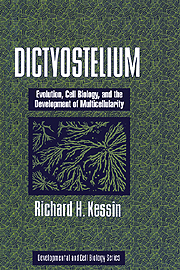Book contents
- Frontmatter
- Contents
- Preface
- 1 A Brief Introduction to Dictyostelium discoideum and its Relatives
- 2 A History of Research on Dictyostelium discoideum
- 3 The Evolutionary Biology of Dictyostelium
- 4 The Genome and Genetics
- 5 Membranes and Organelles of Dictyostelium
- 6 Cell Motility and the Cytoskeleton
- 7 The Transition from Growth to Development: From Starvation to Self-Sustaining cAMP Signal Relay
- 8 Chemotaxis and Aggregation
- 9 Differentiation and Adhesion in the Aggregate
- 10 The Behavior of Cells in the Slug
- 11 Culmination
- 12 Formation and Germination of Spores
- 13 Resources
- References
- Index
- Plate section
9 - Differentiation and Adhesion in the Aggregate
Published online by Cambridge University Press: 07 October 2009
- Frontmatter
- Contents
- Preface
- 1 A Brief Introduction to Dictyostelium discoideum and its Relatives
- 2 A History of Research on Dictyostelium discoideum
- 3 The Evolutionary Biology of Dictyostelium
- 4 The Genome and Genetics
- 5 Membranes and Organelles of Dictyostelium
- 6 Cell Motility and the Cytoskeleton
- 7 The Transition from Growth to Development: From Starvation to Self-Sustaining cAMP Signal Relay
- 8 Chemotaxis and Aggregation
- 9 Differentiation and Adhesion in the Aggregate
- 10 The Behavior of Cells in the Slug
- 11 Culmination
- 12 Formation and Germination of Spores
- 13 Resources
- References
- Index
- Plate section
Summary
As they collect in the mound, cells begin the transcription of cell type-specific genes, develop adhesion mechanisms, and secrete an acellular covering called the sheath. The loose mound goes on to form a compact hemispherical aggregate and prepares the anterior-posterior pattern of the future slug. The mound has been called the crucible of cellular differentiation and morphogenesis. In earlier days of Dictyostelium research, it was difficult to detect the complex gene induction events and cellular movements that occur within the mound, but as markers of cell-type differentiation have improved, the nature of the differentiation events has begun to unfold. Great efforts in microscopy, notably by the laboratories of Weijer, Siegert, McNally, and Soll, have detected elaborate coordinated movements of cells, not just during aggregation, but within the confines of the aggregate. In this chapter we will examine some of the early events that occur after the amoebae aggregate – how they secrete a covering and how they induce new genes in the loose aggregate. The aggregate is where most prestalk- and prespore-specific genes are first transcribed. This subject encompasses a large and complex literature, and an attempt will be made to put this in context. Following an examination of how the pattern of prestalk and prespore cells forms, the cellular adhesion mechanisms that Dictyostelium employs to hold cells together will be analyzed.
Information
- Type
- Chapter
- Information
- DictyosteliumEvolution, Cell Biology, and the Development of Multicellularity, pp. 139 - 165Publisher: Cambridge University PressPrint publication year: 2001
